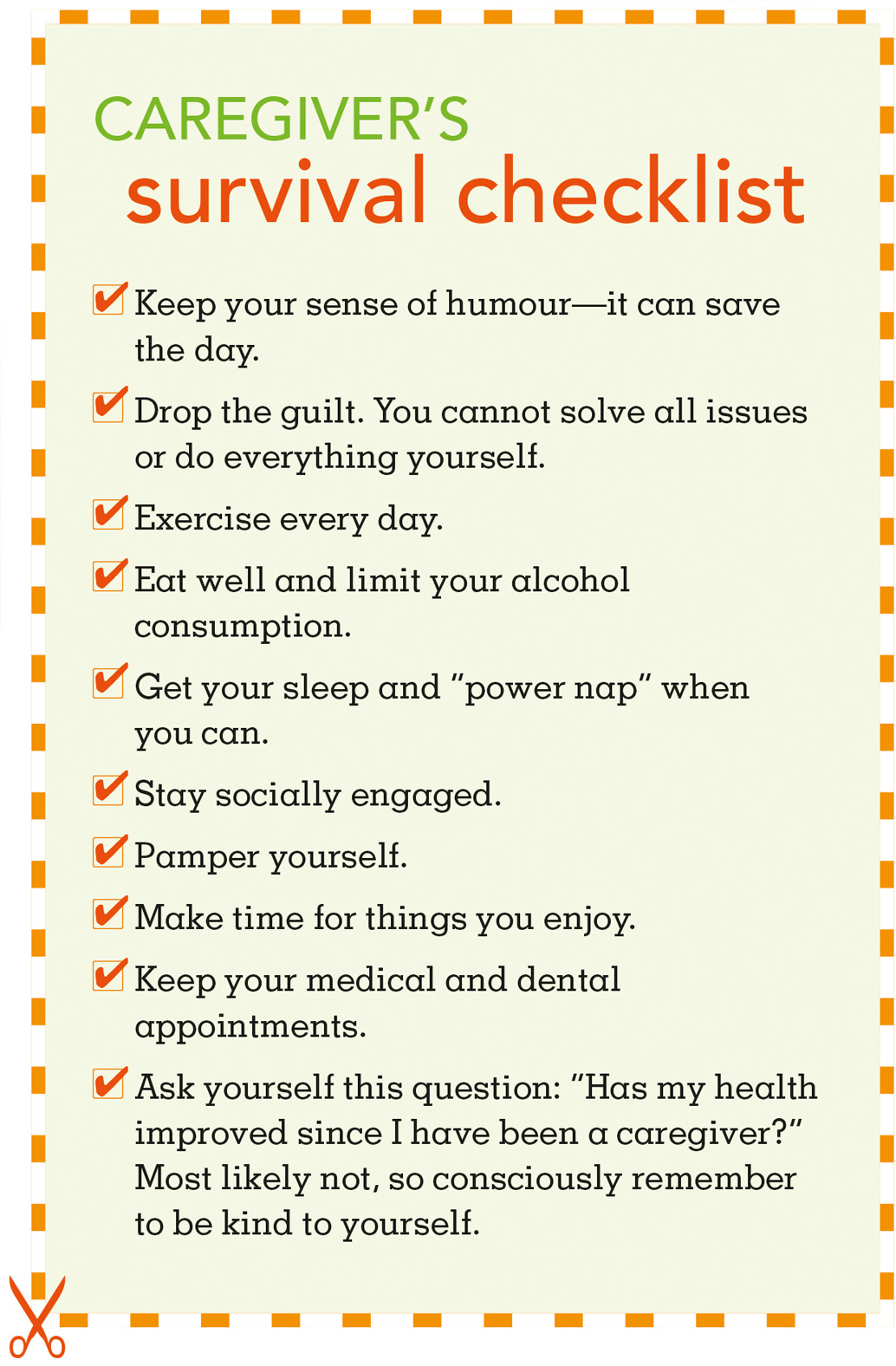Caring for two parents at the same time
By Mary Bart
Sandy’s world has been turned upside down. In the last four months, her mom has had a severe stroke and her dad has been diagnosed with Parkinson’s disease.
Sandy struggles to think about how on Earth she will manage. How can she take care of her parents and of her own family and keep working? Let’s help Sandy double her chances of success as a caregiver as she deals with the double-whammy she now faces. Here are some great ideas that will help Sandy and others who are caring for several people at the same time.
Put on your business-management hat
Caregiving is a job and it needs to be run as a business. This means getting organized. Create a “mobile office.” Purchase an accordion filing binder with a handle and pre-defined sections to manage the paperwork for each person. Dividing the binder into the following sections will save countless hours of time and frustration:
• medications—past and present
• medical treatments—past and present
• banking information
• bills paid and due
• your own out-of-pocket expenses
• phone numbers and email addresses of medical professionals, family, and friends
• legal documents, such as power of attorney
• Canada Revenue Agency (CRA) tax filing slips
• calendar for making appointments
Once you get in the habit of using this mobile office, you will have the key paperwork at your fingertips when needed. This will enable you to be more efficient at the doctor’s office, dealing with a bank or explaining medical issues and medications. Keeping everything organized will decrease your stress and improve your ability and effectiveness in running and managing ever-changing care situations for more than one person.
Pick priorities
Deciding what matters most is a key component of managing care. Priority setting can be divided into two main sections. The first is the actual physical caregiving that you give, such as bathing, feeding or dressing your care recipients. The second section is the setting of “business priorities” for tasks, appointments and schedules. Let’s take a look at each.
Physical caregiving
It is especially important to prioritize which of the two people you are caring for will get the most of your attention on any given day or moment. Often, on a daily basis, you will need to determine who is the most stable and predictable, and who is most likely to need more care and attention. To help keep you grounded, create a safe and comfortable environment for the most stable of the two at that moment—perhaps putting on a movie or their favourite television show to keep them happy for an hour. This will allow you to focus your energy on the more-needy parent. As the physical, mental and spiritual health of both care recipients changes, you will need to adapt and shift your focus and energies as required.
Business priorities
The second part of setting priorities is your ability to focus on the “business priorities.” Create a written list of all the things that need to be done and divide those tasks into groups based on their importance. If possible, create an adjustable plan of what has to happen and what could get pushed off the list for another week (or removed altogether). For example, perhaps there is a medical appointment that has to happen this week, while taking a loved one to get their hair cut or to the bank, that could wait another few days. Making decisions and creating lists and plans will give you peace of mind. It will also allow you to more easily “push back” when you receive unnecessary requests from others or need to explain yourself.
Are you in or out?
Do you remember the old business expression “Lead, follow or get out of the way”? That expression is a good way to help manage family dynamics, conflicts and expectations as a caregiver. Caregivers have to make tough decisions every day, some of which might not sit well with others. And, as one of my friends is fond of saying, “Wouldn’t it be helpful if family members communicated and accepted what each person is ready, willing and able to contribute to help care for a loved one, and not pass judgement?”
When you’re in the thick of it, it is vitally important to look out for yourself. Communicate your own needs, limits and resources. Knowing what role everyone is prepared or not prepared to play might cause disappointments and conflicts, but it will quickly show you where everyone stands. These difficult conversations about who will “Lead, follow or get out of the way” are all about setting expectations, so that you can plan and manage accordingly.
Get involved
Connecting with the local agencies that deal specifically with the health issues of the people for whom you are caring is essential. In Sandy’s case, she could reach out to the local chapters of the Heart and Stroke Foundation and Parkinson Canada. These groups offer activities, education and support. With guidance, caregivers can learn more about how to manage the health issues at play, both now and in the future. Many local chapters have caregiver peer-support programs that will help Sandy and others learn that they are not alone. She will likely find comfort and support from meeting with other families who are dealing with similar circumstances.
Sandy might also want to contact the local hospital, library or seniors group in her area to see what support services they offer.
Seek help, twice
No matter how skilled, dedicated or passionate you are, at some point you will have to accept the reality that extra help is required for one or both parents. Caregiving is only sustainable when you have a team working with you.
Deciding who will be on your team can be an ever-changing challenge. Sometimes family and friends will help, or a homecare agency might fill in the gaps, especially when there are two sets of complex needs. Part of accepting help is being able to change your expectations on how care is provided. Create a handbook for each parent where instructions and notes can be shared. Treat those being cared for as individuals and honour their preferences, interests and individual style. Someone else will make a meal differently, help out in the bathroom not exactly as you would or help dress your loved one in a different sweater than you would have chosen. Fret not. Others can often do things well—sometimes even better than you—and your parents will gradually adjust.
 As you work with your care team, remember to be thankful. Even a one-hour break can be a wonderful treat. It takes a village to offer sustainable care. Create your village, adjust when required and always praise those who go the extra mile.
As you work with your care team, remember to be thankful. Even a one-hour break can be a wonderful treat. It takes a village to offer sustainable care. Create your village, adjust when required and always praise those who go the extra mile.
Embrace change
Change is a natural part of life as a caregiver. Health issues, family dynamics and resources seem to never stay the same. What worked last week might no longer work today. Stay calm and find ways to anticipate change and, when it comes, accept it and work with it as best you can. Having a sense of humour is also a great “change-management” tool.
Experts suggest that there are two types of change. One type is when things get worse, sometimes instantly, such as your loved one falls in the bathroom and breaks a hip. The other type is when change adds value, dignity or convenience to the caregiver situation, such as when the grocery store has online ordering or the pharmacy starts delivering prescriptions and medical supplies to save you the trip.
Create great memories
Capturing special moments and creating great memories will help you through the hard times and bring a smile to your face when you look back. In fact, the memories you make throughout your caregiver journey will be of great value to you, the people for whom you are caregiving, and their families and friends. Here are some ideas to consider to help you create great memories.
Find joy in the simple things
Live in the moment and acknowledge when things go well. It could be the joy of having made a simple soup and sandwich for lunch that everyone enjoyed. These typical daily moments can create lasting, happy memories and stability. For example, I fondly remember the egg sandwiches and mushroom soup lunches that I made for my parents. We all loved those meals and they were some of our best, happy times together.
Keep a camera nearby
Today, digital cameras are everywhere, including in our phones. Consistently think about taking pictures. Spontaneous moments are often the best (and funniest) to capture. Take pictures of your loved ones individually, together and, yes, do a few selfies too. These pictures will last a lifetime and bring great joy for years.
Do something separately and new together
Regardless of health limitations, think of something new that each person can enjoy. Be creative and see if there is something different that can break up the daily routine while being enjoyable and manageable for all. Perhaps you could ask a friend to drop by with their dog for a visit or take a drive to a new area of town. Try having something different for dinner or eating on your best tableware. Watching movies or listening to music can create a calmer atmosphere and new memories, and break the drag of the daily routine.
Leverage the Internet
Social media tools such as Skype and Facebook can be wonderful ways to connect. These are powerful, inexpensive way to stay in touch and build amazing memories.
Celebrate
Don’t forget to celebrate the good times together. This could be as simple as acknowledging that the day went well or honouring special events such as birthdays, family events and holidays. Bring treats, put on some music, take lots of pictures and know that sometimes life can be really great.
 One for two
One for two
Caring for two people at the same time can indeed be “double trouble” and some may even say a “double whammy”—alternatively, it can be looked at as a time to create twice the good memories. Success as a caregiver is supported by careful planning, seeking the right help and getting the ongoing education you need. Sandy and others caring for several people at the same time will, no doubt, have twice the pride and joy from their efforts.
Mary Bart is the chair of Caregiving Matters, an Internet-based charity that offers education and support to family caregivers.












